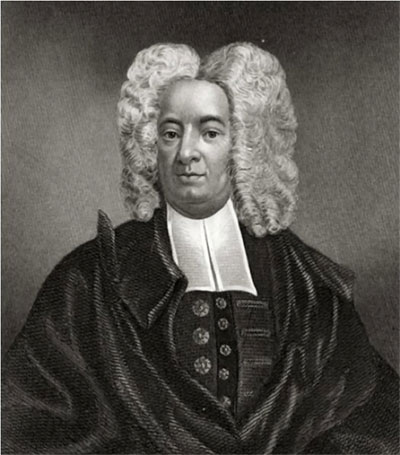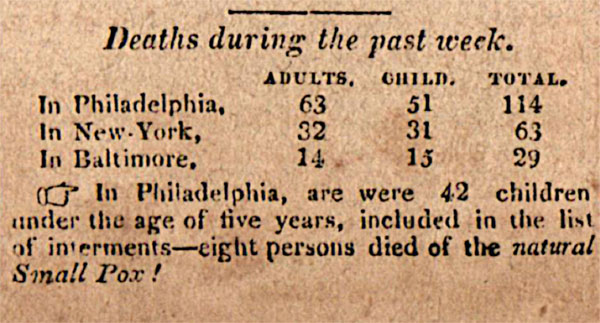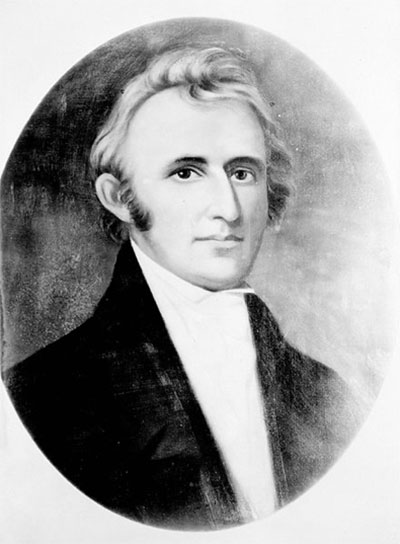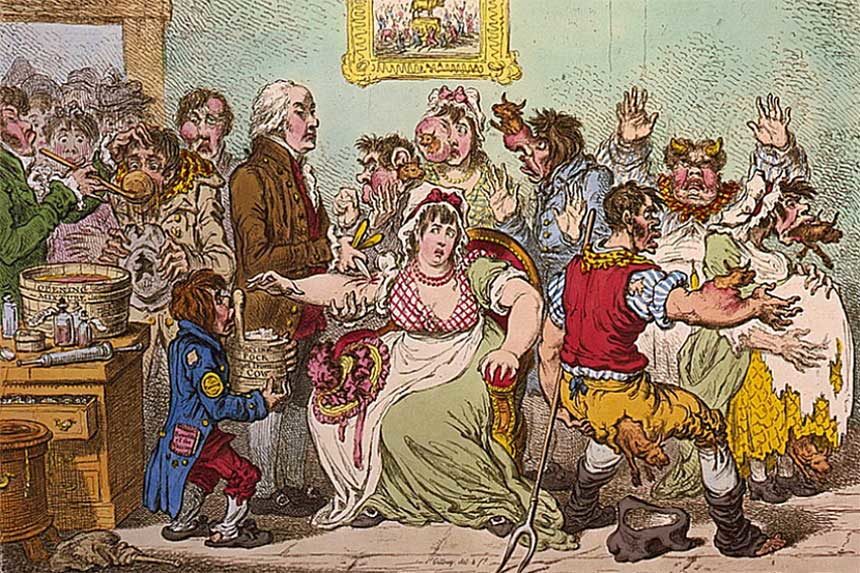Vaccination has always been a divisive issue. As early as 1821, public reaction against inoculation caused the federal government to close down a vaccine program to prevent smallpox.
In its time, smallpox was one of the most fearful illnesses that could strike humans. It could cover a patient’s body in pustules in just 24 hours. If patients were lucky, they suffered for only two to three weeks and were left with depigmented skin and disfiguring scars. The unlucky ones — 30–50 percent of patients — died.
One of the first advocates of inoculation was the influential minister Cotton Mather, who learned about it from his slave Onesimus. He began promoting the idea to New Englanders, and it was largely through his efforts that the 1721 smallpox epidemic in Boston was contained.

But the idea ran into strong resistance. First, there was the vaccine itself. It was made from the serum of cows infected with cowpox that, when injected into healthy people, rendered them immune to smallpox. But people were understandably reluctant to introduce substances from diseased animals into their systems.
Secondly, many American clerics of the early republic denounced inoculation, claiming that it interfered with the Divine will. It might give immunity to sinners whom God was planning to smite as punishment. Cotton Mather received death threats for thwarting the will of God, one critic even attempting to blow up his house.
Lastly, there were the objections of merchants. Worrying that any talk of smallpox would hurt business, they downplayed or dismissed any news of smallpox cases. But in 1777, there was no denying that smallpox was killing the revolutionary army faster than the British. John Adams reported ten soldiers were killed by disease for every one killed in battle. That winter, Washington ordered a mass inoculation of his army.

As a result, the Continental army could remain in the field instead of field hospitals. President James Monroe was reminded of that success in 1813 when smallpox outbreaks began recurring. In response he signed “An Act to Encourage Vaccination.” It established the United States Vaccine Agency “to preserve supplies of genuine vaccine matter and furnish the same to any citizen of the United States.”
Dr. James Smith accepted the position as its director, a decision he might have later regretted. He was given no staff and no funding, and he faced opposition from state governments, which claimed the constitution gave no authority over public health issues to the federal government. Other doctors protested Smith’s agency because it allowed non-physicians to perform vaccination without the hefty fees doctors charged.
And then came the Tarboro Scandal.
In 1821, Dr. John Ward, an “auxiliary vaccine agent” in North Carolina, noted a rising number of smallpox cases in the area around Tarboro. He asked Smith for a supply of vaccines, and Smith promptly responded. But he accidentally sent samples of the smallpox virus. When they arrived, Ward didn’t read the label that would have warned him he’d received the wrong materials. He began inoculating area residents with live smallpox. By late winter, 60 people had contracted smallpox and ten had died.
Dr. Ward shifted all the blame onto Dr. Smith, and his accusations were taken up by Congressman Hutchins Burton of North Carolina. Burton proclaimed that the Vaccine Agency and Dr. Smith had, through indifference, “slaughtered citizens of North Carolina.” He also claimed, falsely, that Smith had also introduced smallpox to the interior of the nation when, previously, it had been confined to coastal cities.

A Congressional investigation into the matter confirmed the mistake, but also exonerated Dr. Smith and praised his agency’s work. Congressman Burton had planned to make political capital on a critical report. So he demanded another committee and this time had himself appointed to it. He wrote its final report, which was, not surprisingly, extremely critical.
Now rumors began circulating that Dr. Smith had been somehow profiting from the vaccine’s use, and was even spreading smallpox on purpose.
Burton had two reasons for attacking Smith. He wanted to show his constituents that he was representing their anger in Washington. But there was also a political reason. Burton, like many anti-Democrats of the period, jealously guarded state sovereignty against perceived federal intrusion. Public health programs should be carried out by state officials, he believed. In the hands of the federal government, these programs led to despotic power
Sensing a “violent prejudice” against Dr. Smith, President Madison removed him from his position.
Smith fought to save his reputation. He launched a promotional campaign, publishing pro-vaccination papers and promising to supply vaccines at his own expense. But public resentment proved stronger than his reasons. The outcome was reported in the Saturday Evening Post on April 27, 1822:
In the House of Representatives of the United States, on Tuesday last, the Bill for abolishing the Vaccine Agency was under consideration, and after considerable debate, carried — Ayes 102 — Nays 57.
Epidemics of smallpox were eventually joined by outbreaks of cholera, diphtheria, measles, typhus, anthrax, and yellow fever.
But the federal government avoided any vaccination programs for the rest of the century.
Featured image: Caricature of vaccination scene at the Smallpox and Inoculation Hospital at St. Pancras, showing Dr. Jenner vaccinating frightened young woman, and cows emerging from different parts of people’s bodies (Library of Congress)
Become a Saturday Evening Post member and enjoy unlimited access. Subscribe now




Comments
Cotton Mather didn’t use Cowpox. That form of vaccination came in 1796 with Edward Jenner. In the 1721 Boston epidemic they would have been introducing the actual smallpox virus into the skin.